The Predictive Touch Market is estimated to be valued at USD 0.8 billion in 2025 and is projected to reach USD 9.3 billion by 2035, registering a compound annual growth rate (CAGR) of 27.5% over the forecast period.
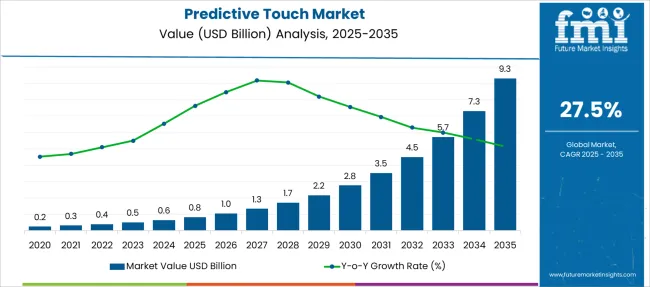
| Metric | Value |
|---|---|
| Predictive Touch Market Estimated Value in (2025 E) | USD 0.8 billion |
| Predictive Touch Market Forecast Value in (2035 F) | USD 9.3 billion |
| Forecast CAGR (2025 to 2035) | 27.5% |
The predictive touch market is witnessing steady advancement as demand for intuitive, gesture-based interfaces grows across healthcare, retail, industrial automation, and consumer electronics sectors. Increasing expectations for seamless human–machine interaction are prompting adoption of AI-integrated touch solutions capable of anticipating user intent.
Integration of predictive algorithms into traditional touch platforms has enhanced responsiveness and efficiency, enabling more fluid user experiences. Developments in haptics, capacitive sensing, and sensor fusion are pushing boundaries of what predictive touch systems can achieve across operating environments.
Regulatory emphasis on touchless and hygienic interfaces, especially in post-pandemic settings, is accelerating innovation and use cases in clinical and public-facing domains. Future growth is expected to be influenced by embedded AI chipsets, real-time edge analytics, and adaptive software platforms that tailor interactions based on behavioral patterns and contextual awareness.
The market is segmented by Platform and Application and region. By Platform, the market is divided into Windows-based Predictive Touch, Android-based Predictive Touch, and IOS-based Predictive Touch. In terms of Application, the market is classified into Healthcare, Banking Financial Services and Insurance, Government, Public Administration, Utilities, Pharmaceutical, Telecom and IT, Retail, Transportation, and Logistics, Manufacturing, Media and Entertainment, Energy - Oil, Gas and Electricity, Engineering and Construction, Tourism, and Others. Regionally, the market is classified into North America, Latin America, Western Europe, Eastern Europe, Balkan & Baltic Countries, Russia & Belarus, Central Asia, East Asia, South Asia & Pacific, and the Middle East & Africa.
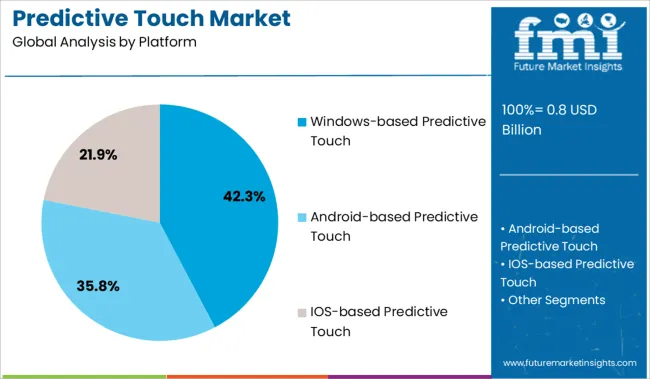
Windows-based predictive touch platforms are anticipated to lead the market with a 42.3% revenue share in 2025, driven by their widespread enterprise deployment and deep integration within industrial and healthcare ecosystems. Their dominance is supported by compatibility with existing IT infrastructure, legacy systems, and secure enterprise-grade applications.
Predictive touch solutions developed on Windows platforms benefit from robust developer tools, frequent software updates, and broad support for third-party hardware. Additionally, the platform’s scalability and backward compatibility enable long-term cost efficiency for OEMs and system integrators.
High reliability, native multi-language support, and ease of customization have further promoted its adoption across mission-critical environments. As industries seek to balance operational uptime with intuitive UX, Windows-based systems continue to be favored for stability, integration depth, and predictive interface functionality.
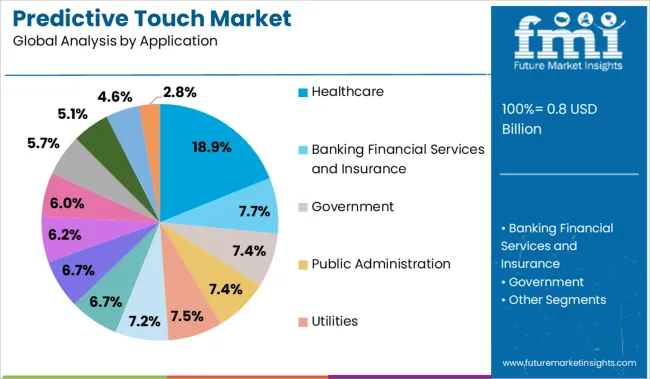
The healthcare sector is projected to hold 18.9% of the total market revenue in 2025, making it the leading application segment for predictive touch technologies. This leadership is being driven by increased deployment of contactless interfaces in clinical, diagnostic, and patient-facing environments where hygiene and user accuracy are paramount.
Predictive touch systems in healthcare support faster input, reduced surface contamination, and improved user throughput key priorities in both inpatient and outpatient settings. The integration of gesture-based interfaces in medical equipment, kiosks, and electronic health record (EHR) systems is improving workflow efficiency and clinician experience.
Furthermore, predictive touch interfaces reduce cognitive load for medical staff by anticipating user input, enhancing interaction accuracy, and minimizing error rates. Regulatory compliance requirements around medical device safety and user accessibility have also supported investment in advanced interface technologies within the healthcare landscape.
Increasing Technological Advancement to Boost the Market Growth
Increased use of Internet of Things (IoT) and Artificial Intelligence (AI) technologies, in many industrial and residential applications had been witnessing a boost in the growth of the global Predictive Touch Market. The rapid digital transformation which is also projected to have a positive impact on the growth of the predictive touch market in the coming years. The global Predictive Touch market is also predicted to grow due to a surge in the transformation of business models, supported majorly by the increase in the adoption of advanced telecommunication services, such as 5G.
Advancement of data extraction algorithm to facilitate the growth of predictive gadgets are becoming an attractive opportunity to invest in predictive touch technology. The tendency of a machine to think and work in a similar way to that of humans is catering to new opportunities, to develop more efficient predictive systems, which is expected to be another significant driver for market growth.
Artificial intelligence and conventional touchscreen technology, are coupled together to arouse the demand for innovative products such as advanced predictive touch techniques. Further need for change and more advanced interactive technology are the two key drivers of the Predictive Touch Market.
Lack of Technical Workforce May Impede the Market Growth
Although the predictive touch market has numerous end-uses, there are numerous obstacles that likely pose a challenge to market growth.
The lack of a trained and proficient workforce is the major challenge faced by organizations in the correct deployment of the Predictive Touch Market.
The predictive Touch Market is under an ongoing research process, owing to these tremendous untapped opportunities are hidden to explore which is contributing to the growth of the market.
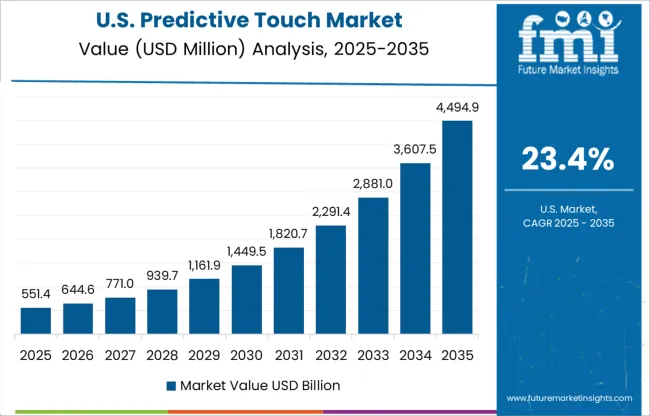
The presence of well-developed technical infrastructure boosts the market in North America.
North America dominated the global predictive touch market and accounted for 36.3% market share, and the global Predictive Touch Market is anticipated to spur over the forthcoming years in this region. Also, the growing demand for innovative business intelligence products in the North Americann region has assisted the growth of the predictive touch market in this region.
The increase in applications of the predictive touch in automobile and healthcare industries because of its benefits over conventional touchscreens, due to which the predictive touch market is expected to have potential growth in North America. Increased internet usage and a surge in smartphone users have inundated the automotive industry, fuelling additional market expansion.
Also, due to its favorable technological infrastructure, greater participation by the region's top automotive businesses, and the presence of key players, such as Microsoft, Nuance communication, and growing purchasing power parity (PPP) of the populace, the USA dominates the predictive touch market.
The heightened growth being witnessed in the USA can also be attributed to the following factors, such as the densely populated key players in the region, the rising adoption rate for new-age technology, and a surging application base in the downstream industries. The thriving automotive and transportation industries are further contributing to the development and advancements of the predictive touch market in the USA. The usage of predictive touch, an evolving HMI technology, substantially improves the performance and usability of in-vehicle displays. The predictive touch enables autonomous auto-selection of the predicted interface component and simplifies the selection task with the help of early prediction of the interface item the passenger or driver intends to opt for on display.
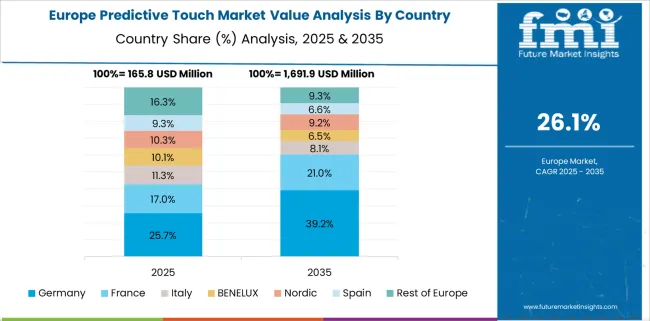
Ongoing Technical Development to Drive Market Growth
According to Future Market Insights, Europe is expected to provide immense growth opportunities for the predictive touch market due to the technological development in the region.
Europe’s predictive touch market accounts for a 21.7% share of the total global market. The European Market is expected to exhibit growth at a swift pace owing to the large-scale adoption of predictive analytics supporting tools in industries across the region. Due to the increased technological usage in the automotive industry, the predictive touch market will expand at a significant rate in Europe. The market has grown as a result of increased sales of both premium and affordable cars over time. Additionally, the growing propensity to use high-tech features has fuelled the market's expansion.
Since COVID-19, technologies supporting human health and hygiene have been enjoying heightened preference. In the United Kingdom, for instance, in the year 2024, the University of Cambridge and Jaguar Land Rover together developed new contactless touchscreen technology for drivers to fight off bacteria and viruses. The ‘predictive touch’ employs artificial intelligence and sensors to anticipate the user’s intended aim on the touchscreen, such as temperature controls, satellite navigation, or entertainment settings, without having to touch the screen. The pioneering system is developed to make its vehicles safer and healthier for the environment and humans.
The Asia Pacific is expected to register the fastest growth in revenue generation for the predictive touch market due to the large population in countries such as China and India. Moreover, the expansion of the IT sector in countries such as China, India, and Japan is anticipated to elevate the market demand in the near future.
Factors such as the market players increasingly deploying the AI platform cloud service for improving the data science operations in the region are expected to accelerate the growth of the predictive touch market during the forecast period.
The rapid increase in the manufacturing and IT & Telecommunication industry is one of the major factors that will boost the market growth in the forthcoming years. In addition, the market is gaining traction and is expected to fuel, owing to the increasing demand for advanced applications development in this region.
The Japan predictive touch market is expected to observe robust penetration in the years to come. This can be ascribed to the adoption of this non-touch technology in an extensive range of public applications, such as medical facilities, ATMs, and elevators, among other businesses where hygiene maintenance is the most crucial factor, such as food-related companies. Further, due to the growing perception of this technology as a contributor to improved hygiene in society, the predictive touch technology is expected to witness high demand in Japan owing to the large pool of geriatric population in the country.
The South Korean predictive touch market is expected to flourish over the forthcoming years. Regional growth has been driven by technological innovations in the past few years. For instance, in 2020, iOS9 introduced predictive touch technology crucial for the Apple stylus. In iOS 9, the Cocoa Touch Framework has gained new predictive touch competencies, helping improve the speed and precision of touch-based input.
Since the public is already used to using screens by tapping and clicking, assuming they all are touchscreen, the successful adoption of predictive touch technology would require rigorous initiatives to educate the masses with the help of public information campaign regarding the development of a new screen. Once established, the touchless touch screen can be used for endless use cases, such as ticketing at rail stations, lunch line checkout at some high schools, and check-in terminals at the airport, etc.
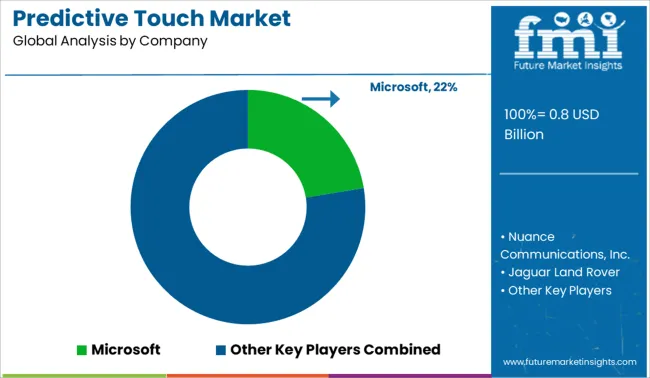
Since the Market is very niche, very few players are currently catering to the predictive touch market, some of the key participants present in the global predictive touch market include Microsoft, Nuance Communication, Jaguar Land Rover, dotData Enterprise, Smartia, innoSEP, Cognexa among others. Some key-development of the major players is listed below :
| Report Attribute | Details |
|---|---|
| Growth Rate | CAGR of 27.5 % from 2025 to 2035 |
| Expected Market Value (2025) | USD 0.8 billion |
| Anticipated Forecast Value (2035) | USD 9.3 billion |
| Base Year for Estimation | 2024 |
| Historical Data | 2020 to 2024 |
| Forecast Period | 2025 to 2035 |
| Quantitative Units | Revenue in USD Million and CAGR from 2025 to 2035 |
| Report Coverage | Revenue Forecast, Volume Forecast, Company Ranking, Competitive Landscape, Growth Factors, Trends and Pricing Analysis |
| Segments Covered | Application, Platform, Region |
| Regions Covered | North America; Latin America; Europe; Asia Pacific; Middle East and Africa |
| Key Countries Profiled | USA, Canada, Brazil, Argentina, Germany, UK, France, Spain, Italy, Nordics, BENELUX, Australia & New Zealand, China, India, ASEAN, GCC, South Africa |
| Key Companies Profiled | Microsoft; Nuance Communications Inc.; Jaguar Land Rover; dotData Enterprise; Smartia; innoSEP; cogneXa |
| Customization | Available Upon Request |
The global predictive touch market is estimated to be valued at USD 0.8 billion in 2025.
The market size for the predictive touch market is projected to reach USD 9.3 billion by 2035.
The predictive touch market is expected to grow at a 27.5% CAGR between 2025 and 2035.
The key product types in predictive touch market are windows-based predictive touch, android-based predictive touch and ios-based predictive touch.
In terms of application, healthcare segment to command 18.9% share in the predictive touch market in 2025.






Full Research Suite comprises of:
Market outlook & trends analysis
Interviews & case studies
Strategic recommendations
Vendor profiles & capabilities analysis
5-year forecasts
8 regions and 60+ country-level data splits
Market segment data splits
12 months of continuous data updates
DELIVERED AS:
PDF EXCEL ONLINE
Predictive Disease Analytics Market Size and Share Forecast Outlook 2025 to 2035
Predictive Quality Assurance Equipment Market Size and Share Forecast Outlook 2025 to 2035
Predictive Analytics Market Size and Share Forecast Outlook 2025 to 2035
Predictive Maintenance Market Analysis – Growth & Industry Trends through 2034
Predictive Automobile Technology Market
AI-driven Predictive Maintenance Market Forecast and Outlook 2025 to 2035
Transportation Predictive Analytics Market Report – Growth & Forecast 2017-2027
Touch Controller IC Market Size and Share Forecast Outlook 2025 to 2035
Touch Panel Market Size and Share Forecast Outlook 2025 to 2035
Touchless Sensing Market Size and Share Forecast Outlook 2025 to 2035
Touch Screen Film Market Size and Share Forecast Outlook 2025 to 2035
Touchscreen Controller Market Growth - Trends & Outlook 2025 to 2035
Touchless Tubes Market
Touchscreen Gloves Market
Touch Screen Module Market
Soft Touch Lamination Film Market Size and Share Forecast Outlook 2025 to 2035
Soft Touch Polyurethane Coatings Market Trends 2025 to 2035
Zero-Touch Provisioning (ZTP) Market - Growth & Demand 2025 to 2035
Soft Touch Film Market Analysis & Growth 2024-2034
Multi Touch Sensing Market Size and Share Forecast Outlook 2025 to 2035

Thank you!
You will receive an email from our Business Development Manager. Please be sure to check your SPAM/JUNK folder too.
Chat With
MaRIA